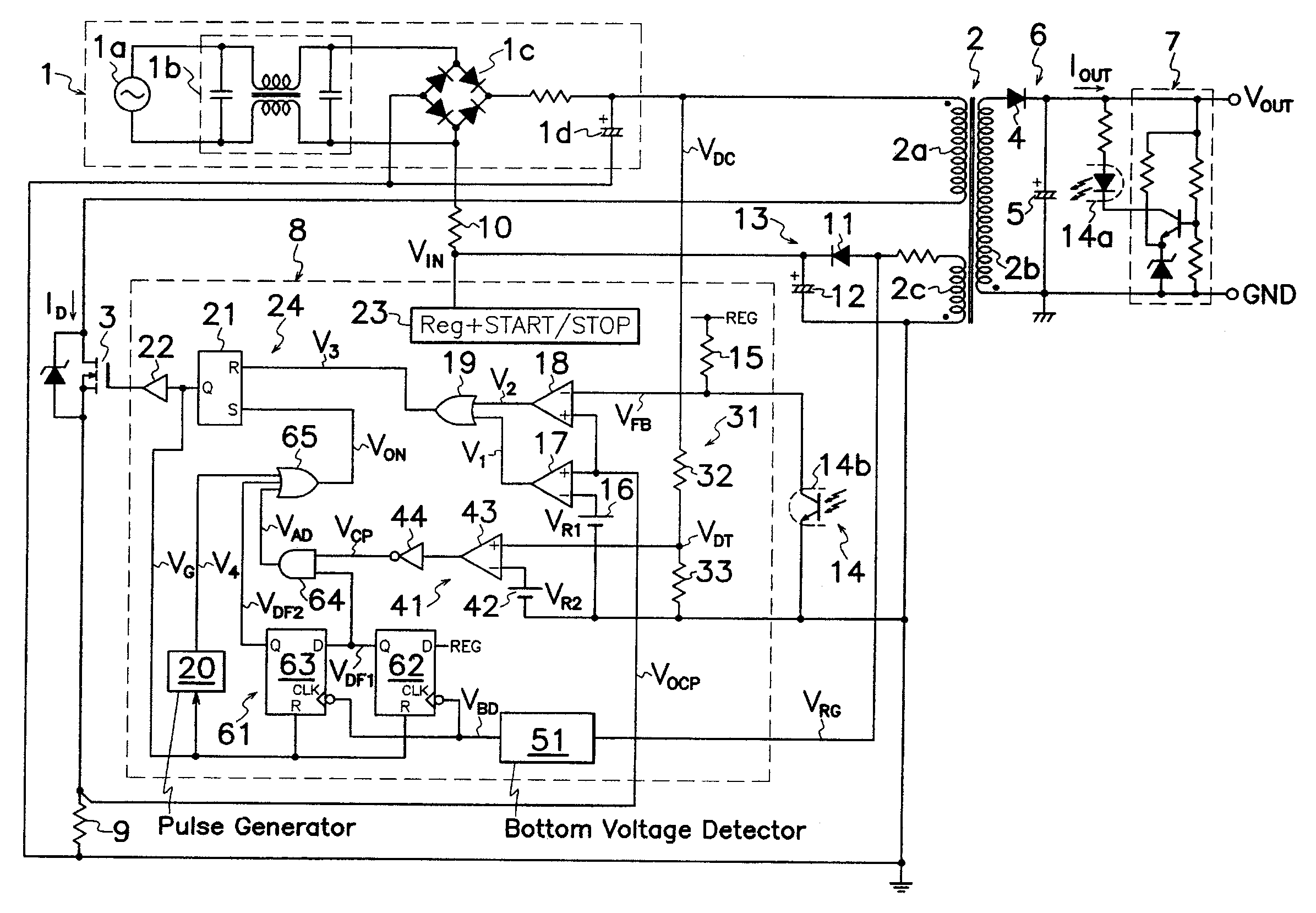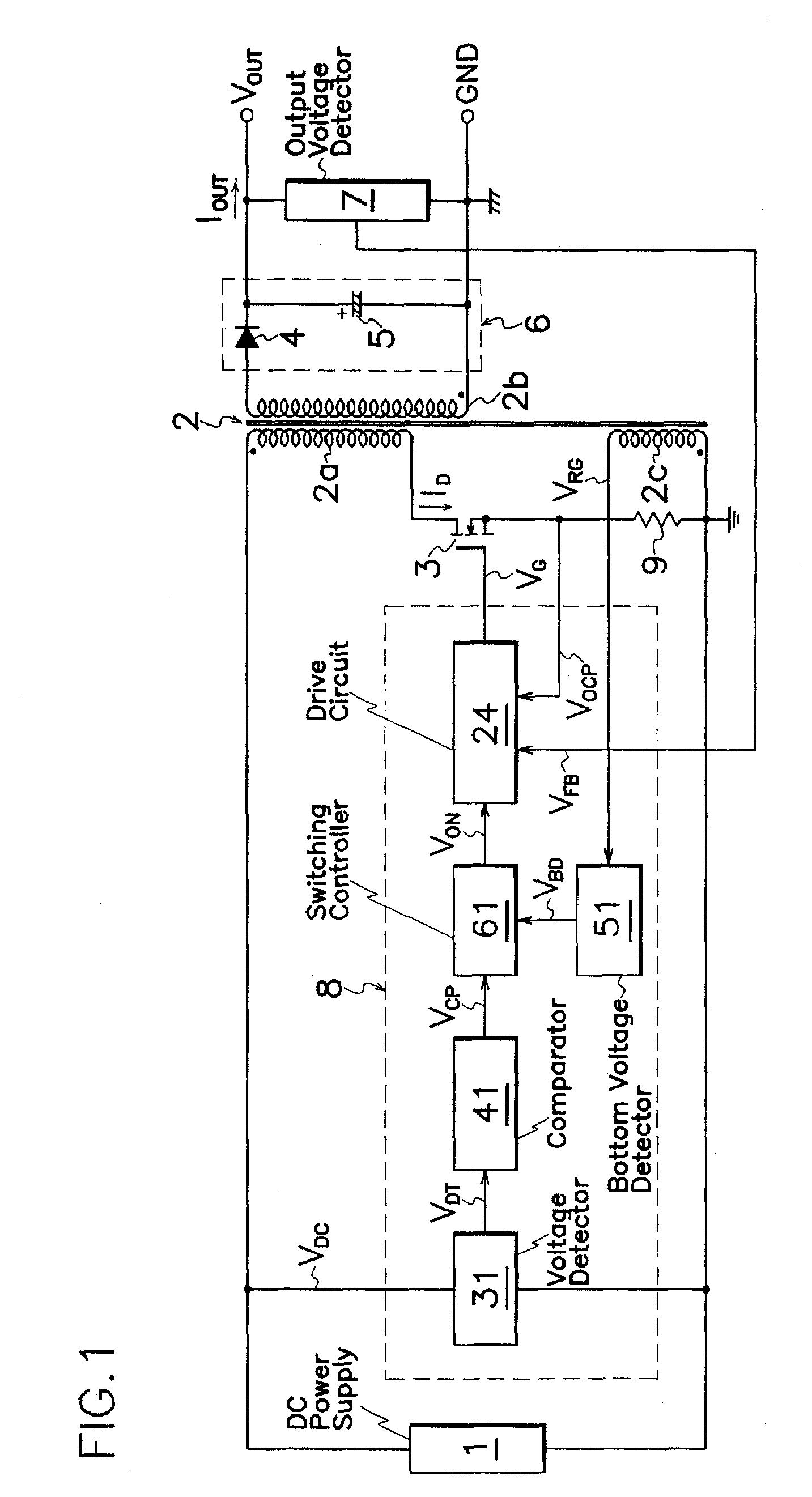Switching power source
a power source and power supply technology, applied in the direction of electric variable regulation, process and machine control, instruments, etc., can solve the problems of power source giving, and increasing switching loss and conversion efficiency in dc-dc converters, so as to improve the conversion efficiency of power sources and reduce switching losses. , the effect of wide fluctuation range of power voltag
- Summary
- Abstract
- Description
- Claims
- Application Information
AI Technical Summary
Benefits of technology
Problems solved by technology
Method used
Image
Examples
first embodiment
[0032]FIG. 1 shows the switching power source according to the present invention which comprises a DC power supply 1; a primary winding 2a of a transformer 2 and a MOS-FET (MOS type Field Effect Transistor) 3 as a switching element connected in series to DC power supply 1; an output rectifying smoother 6 which has an output rectifying diode 4 and an output smoothing capacitor 5 connected to a secondary winding 2b of transformer 2 to produce a DC output voltage VOUT; an output voltage detector 7 for detecting DC output voltage VOUT; a control circuit 8 which includes a drive circuit 24 for producing drive signals VG to MOS-FET 3 based on detection signals VFB from output voltage detector 7 to keep DC output voltage VOUT on a substantially constant level; and a current detecting resistor 9 for detecting electric current ID flowing through primary winding 2a of transformer 2 or MOS-FET 3 as a corresponding voltage to produce a detection signal VOCP to control circuit 8. Then, control c...
second embodiment
[0046 shown in FIG. 10 is advantageous in that RS-flip flop 45 can certainly keep the voltage level of comparative output signal from comparing circuit 43 to minimize power loss by input voltage detector 31 and further improve conversion efficiency in a wide fluctuation range of power source voltage. Incidentally, similar effects can be obtained in comparing an average or effective value of detection voltage VDT from AC input voltage VAC with reference voltage VR2 in lieu of comparing a peak value of detection voltage VDT from AC input voltage VAC with reference voltage VR2.
[0047]FIG. 11 represents a third embodiment of the switching power source according to the present invention. This power source comprises a level shift circuit 34 as an input voltage detector for detecting voltage VRG appearing on drive winding 2c of transformer 2 during the on period of MOS-FET 3, and a D-flip flop 47 adopted in place of inverter 44 in comparator 41 shown in FIG. 2. Level shift circuit 34 compri...
third embodiment
[0050]In the third embodiment, during the on period of MOS-FET 3, drive winding 2c of transformer 2 produces voltage VRG proportional to AC voltage supplied from AC power source 1a, and therefore, switching frequency of MOS-FET 3 can be controlled to an optimal frequency in response to AC voltage supplied from AC power source 1a by level-shifting circuit 34 which detects voltage VRG on drive winding 2c of transformer 2. As trailing edge of output signal VG from RS-flip flop 21 appears on the order of 50 to 500 nanoseconds earlier than turning off of MOS-FET 3, it is possible to avoid malfunction of comparator 41 resulted from switching noise occurring at the time of turning on or off of MOS-FET 3 by detecting voltage VRG from drive winding 2c of transformer 2 synchronously with trailing edge of output signal VG from RS-flip flop 21 and before turning on or off of MOS-FET 3.
PUM
 Login to View More
Login to View More Abstract
Description
Claims
Application Information
 Login to View More
Login to View More - R&D
- Intellectual Property
- Life Sciences
- Materials
- Tech Scout
- Unparalleled Data Quality
- Higher Quality Content
- 60% Fewer Hallucinations
Browse by: Latest US Patents, China's latest patents, Technical Efficacy Thesaurus, Application Domain, Technology Topic, Popular Technical Reports.
© 2025 PatSnap. All rights reserved.Legal|Privacy policy|Modern Slavery Act Transparency Statement|Sitemap|About US| Contact US: help@patsnap.com



